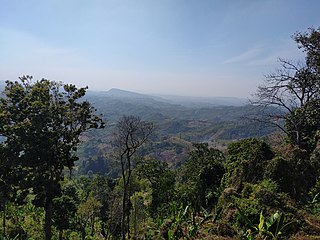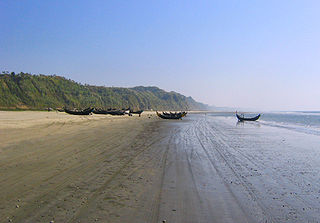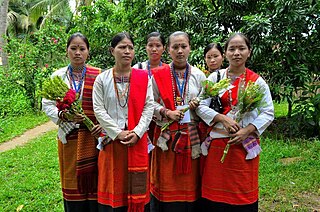Related Research Articles

The Chittagong Hill Tracts, often shortened to simply the Hill Tracts and abbreviated to CHT, are group of districts within the Chittagong Division in southeastern Bangladesh, bordering India and Myanmar (Burma). Covering 13,295 square kilometres (5,133 sq mi), they formed a single district until 1984, when they were divided into three districts: Khagrachari District, Rangamati Hill District, and Bandarban District.

The Chakma people are a tribal group from the eastern-most regions of the Indian subcontinent. They are the largest ethnic group in the Chittagong Hill Tracts region of southeastern Bangladesh, and the second-largest in Mizoram, India. Other places in Northeast India also have significant Chakma populations. Around 60,000 Chakma people live in Arunachal Pradesh, India; a first generation migrated there in 1964 after the Kaptai Dam tragedy. Another 79,000 Chakmas live in Tripura, India, and 20,000-30,000 in Assam, India.

The Marma, formerly known as Moghs or Maghs, are the second-largest ethnic community in Bangladesh's Chittagong Hill Tracts, primarily residing in the Bandarban, Khagrachari and Rangamati Hill Districts. Some Marmas live in Bangladesh's coastal districts of Cox's Bazar and Patuakhali, while others live in Tripura, India and Myanmar. There are over 210,000 Marmas living in Bangladesh. Since the 16th century, the Marma have considered the Bengal's Chittagong Hill Tracts their home, where they have established the Bohmong and Mong Circles (chiefdoms).

Rangamati Hill District, is a district in south-eastern Bangladesh. It is a part of the Chittagong Division and the town of Rangamati serves as the headquarters of the district. By area, Rangamati is the largest district of the country.

Rangamati ;(Chakma:𑄢𑄋𑄟𑄖𑄴𑄳𑄠 ) is the administrative headquarters of Rangamati Hill District in the Chittagong Hill Tracts of Bangladesh. The town is located at 22°37'60N 92°12'0E and has an altitude of 14 metres (46 ft). The district is administered by an office named as District Administration, Rangamati.

Bandarban is a district in South-Eastern Bangladesh, and a part of the Chittagong Division. It is one of the three hill districts of Bangladesh and a part of the Chittagong Hill Tracts, the others being Rangamati District and Khagrachhari District. Bandarban district (4,479 km2) is not only the most remote district of the country, but also the least populous. There is an army contingent at Bandarban Cantonment.

Khagrachari is a district in the Chittagong Division of Southeastern Bangladesh. It is a part of the Chittagong Hill Tracts region.
The indigenous people of Bangladesh refer to ethnic minorities in Chittagong Hill Tracts (southeastern), Sylhet Division (northeastern), Rajshahi Division (west), and Mymensingh Division (north-central) areas of the country. The total population of indigenous ethnic minorities in Bangladesh was estimated to be over 2 million in 2010. They are diverse ethnic communities including Tibeto-Burman, Austric and Dravidian people.

Bangladesh's tourist attractions include historical monuments, resorts, beaches, picnic spots, forests and tribal people, wildlife of various species. Activities for tourists include angling, water skiing, river cruising, hiking, rowing, yachting, and sea bathing.

The Tanchangya people or Tanchangyas are an indigenous ethnic group living in the Chittagong Hill Tracts (CHT) of Bangladesh, Indian states of Tripura and Mizoram, Arunachal and Rakhine state of Myanmar.
Devasish Roy is a Bangladeshi politician and lawyer. He is the titular Raja of the Chakma Circle, Bangladesh's largest indigenous community, and was a member of the United Nations Permanent Forum on Indigenous Issues from 2014 to 2016.
Chittagong Hill Tracts Regulation, 1900 popularly known as Chittagong Hill Tracts manual is a manual enacted by the then British India Government describing how to administer Chittagong Hill Tracts of present-day eastern Bangladesh. It was adopted in place of earlier manuals, after the government realised that the act of 1860 would not work satisfactorily. Since the adoption of the manual, the administration of Chittagong Hill Tracts was carried on in accordance with the rules of the manual.
Kheyang is the exonym of the Hyow. There Kheyang or the Hyow (খিয়াং), are a group of indigenous people inhabiting in the Chittagong Hill Tracts of Bangladesh and the Rakhine State of Myanmar. The word Kheyang originated in khlɔng (see VanBik, 2009: 3–4), which means personin the language. The endonym Hyow means Chin. The Khyang are one of the smallest ethnic groups in Bangladesh with a population of only 2,345 according to the 1991 census. At present, the approximate number of the Khyang in Bangladesh is 4500. They live in Kaptai and Chandraghona in Rangamati Hill District and in Bandarban Sadar, Thanchi and Rowangcchari upazila in Bandarban District. . In Myanmar, they live in the Myebon, Minbya and Ann townships of the Rakhine State.

Bangladeshis are the citizens of Bangladesh, a South Asian country centered on the transnational historical region of Bengal along the eponymous bay.
The Chittagong Hill Tracts lies in the south-eastern part of Bangladesh adjoining international boundaries with Myanmar on the southeast, the Indian states of Tripura on the north and Mizoram on the east. The Chittagong Hill Tracts, formally a single unified district was divided into three separate districts: Khagrachari, Bandarban, and Rangamati during the administrative reorganization in 1984.

The Chakma Circle, also known as the Chakma Raj, is one of three hereditary chiefdoms in the Chittagong Hill Tracts of modern-day Bangladesh. The Chakma Circle encompasses parts of Rangamati Hill District and Dighinala and Rajasthali Upazilas in neighbouring Khagrachari District and Bandarban District respectively. The chiefdom's members are of Chakma descent.
Rangamati Hill District Council is the autonomous government body responsible for the governance of Rangamati Hill District. Brisaketu Chakma is the Chairman of the Rangamati Hill District Council.

The Mong Circle is one of three hereditary chiefdoms in the Chittagong Hill Tracts of modern-day Bangladesh. The jurisdiction of the Mong Circle encompasses parts of Khagrachhari District. The chiefdom's members are of Marma descent and are known as phalansa. Most inhabitants of the Mong Circle settled in the northwest during a migration wave from the Kingdom of Mrauk U between the 16th and 18th centuries, while inhabitants of the other Marma chiefdom, the Bohmong Circle settled in the south and are known as ragraisa.

The Bohmong Circle is one of three hereditary chiefdoms in the Chittagong Hill Tracts of modern-day Bangladesh. The jurisdiction of the Bohmong Circle encompasses parts of Bandarban District. The chiefdom's members are of Marma descent and are known as ragraisa. Most inhabitants of the Mong Circle settled in the south during a migration wave from the Kingdom of Mrauk U between the 16th and 18th centuries, while inhabitants of the other Marma chiefdom, the Mong Circle, settled in the northwest and are known as phalansa (ဖလံသား).
The three districts of the Chittagong Hill Tracts, Bandarban, Rangamati and Khagrachari, still have monarchs. In 1860, the British government divided the Chittagong Hill Tracts into three circles, Chakma, Bomang and Mong. Bomang Circle is located in Bandarban, Chakma Circle in Rangamati and Mong Circle in Khagrachari. The monarchs of these three districts are known as three kings. For hundreds of years, the people of the Chittagong Hill Tracts have been following the orders of the three kings. But the kings do not have much power now. Their activities are limited to issuing permanent resident certificates, tax collection, some social justice, arbitration meetings. But the three kings have a long history.
References
- ↑ Illius, Shamsuddin (December 22, 2017). "Chakma Raja Celebrates 40 Years". The Independent. Retrieved August 3, 2021.
- ↑ "The Bohmong Rajpunyah festival will start on December 21". Prothom Alo. November 30, 2016. Retrieved August 3, 2021.
- ↑ "Bandarban wears festive look as Rajpunyah starts". The Daily Star. January 15, 2010. Retrieved August 3, 2021.
- ↑ "The traditional Rajpunyah started in Bandarban". The Daily Janakantha. December 20, 2014. Retrieved August 3, 2021.
- ↑ "Raj Punyah". Bangladesh National Portal. August 3, 2021.
- ↑ Chakraborty, Milon (January 4, 2013). "Traditional Rajpunyah Starts in Bandarban". The Daily Ittefaq. Retrieved August 3, 2021.
- ↑ Das, S. Basu (January 2, 2013). "The 137th Rajpunyah of Bandarban starts on Thursday". Banglanews24.com. Retrieved August 3, 2021.